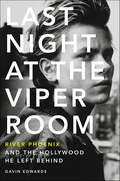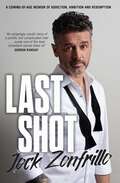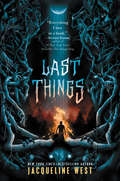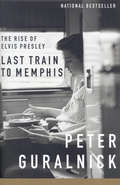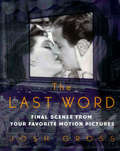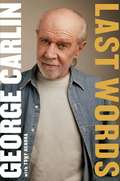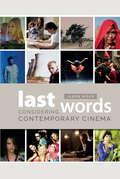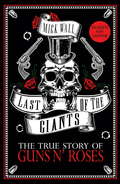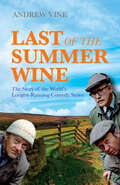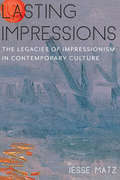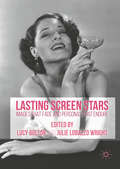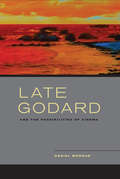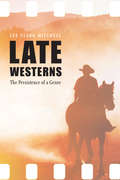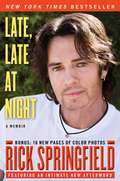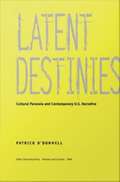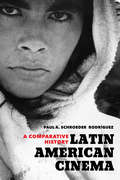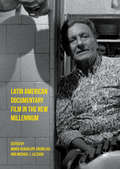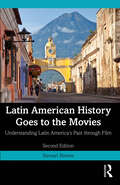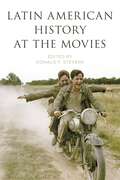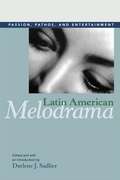- Table View
- List View
Last Night at the Viper Room: River Phoenix and the Hollywood He Left Behind
by Gavin EdwardsA biography elucidating the Academy Award–nominee’s meteoric rise, his tragic end, and his legacy.At the dawn of the 1990s, a new crew of leading men—Johnny Depp, Nicolas Cage, Keanu Reeves, and Brad Pitt—was rocketing toward stardom. River Phoenix, however, stood in front of the pack. But behind Phoenix’s talent and beautiful public face was a young man who had been raised in a cult by nonconformist parents, who was burdened with supporting his family from a young age, and who eventually succumbed to addiction, dying of an overdose in front of the Viper Room, West Hollywood’s storied club, at twenty-three.Last Night at the Viper Room is part biography, part cultural history of the 1990s, and part celebration of a Hollywood icon gone too soon. Full of interviews from his fellow actors, directors, friends, and family, this book shows the role River Phoenix played in creating the place of the actor in our modern culture and the impact his work still makes today.
Last Shot
by Jock ZonfrilloA coming-of-age memoir of addiction, ambition and redemption in the high-stakes world of Michelin star kitchens. From reckless drug addict to one of Australia&’s top chefs and television stars: MasterChef judge Jock Zonfrillo's powerful life story will shock and inspire. Jock&’s life spiralled out of control when he tried heroin for the first time as a teenager while growing up in 1980s Glasgow. For years he balanced a career as a rising star amongst legendary chefs with a crippling drug addiction that took him down many dark paths. Fired from his job at a Michelin star restaurant in Chester, England, after a foul-mouthed rant, Jock made his way to London looking for work and found himself in front of the legendary Marco Pierre White. He credits White for saving his life, but Jock continued to struggle with addiction in a world of excess, celebrity, and cut-throat ambition. On New Year&’s Eve 1999, Jock shot up his last shot of heroin before boarding a plane to Sydney, where he would find passion and new meaning in life in the most unexpected places. There would be more struggles ahead, including two failed marriages, the closure of his prized restaurant during COVID-19, his time on-country, and some very public battles. This is his unforgettable story. Foreword by Jimmy Barnes. Praise for Last Shot "If you get to see yourself in someone else&’s book it&’s a bit of a gift and it is the mark of a good storyteller. I&’m sure as you read this book you will see a bit of yourself too. This is a story of hope. A story of perseverance and resilience. A story of passion and love. A remarkable tale of a remarkable man who took the hard, hard road and made it his own." Jimmy Barnes "Last Shot is Trainspotting meets Kitchen Confidential. Jock&’s ability to not sugarcoat the truth and his brutal honesty about his struggle with his inner demons will resonate with so many people. That coupled with his absolute passion for food, his commitment to highlighting the culture and food of Australia&’s First Nations People and his pure love for his family makes this a truly stunning book. I loved it.&” Actress, Rebecca Gibney&“Oh my goodness what a book. I&’ve just finished it, devoured it in under four hours. I laughed and cried and marvelled at him.&” News Corp's National Entertainment Writer, Lisa Woolford
Last Things
by Jacqueline West"Everything I love in a book."—Victoria Schwab, author of #1 New York Times bestseller This Savage Song“The kind of taut, atmospheric thriller that gets your heart racing and sets your imagination on fire. Sensational.”—Claire Legrand, New York Times-bestselling author of FurybornNew York Times–bestselling author Jacqueline West captivates readers with a dark, hypnotic story about the cost of talent—and the evil that lurks just out of sight. Fans of Holly Black and Victoria Schwab will be mesmerized by this gorgeous, magnetic novel.High school senior Anders Thorson is unusually gifted. His band, Last Things, is legendary in their northern Minnesota hometown. With guitar skills that would amaze even if he weren’t only eighteen, Anders is the focus of head-turning admiration. And Thea Malcom, a newcomer to the insular town, is one of his admirers. Thea seems to turn up everywhere Anders goes: gigs at the local coffeehouse, guitar lessons, even in the woods near Anders’s home.When strange things start happening to Anders, blame immediately falls on Thea. But is she trying to hurt him? Or save him? Can he trust a girl who doesn’t seem to know the difference between dreams and reality? And how much are they both willing to sacrifice to get what they want? Told from Anders’s and Thea’s dual points of view, this exquisitely crafted novel is full of unexpected twists and is for fans of Holly Black’s The Darkest Part of the Forest and Melissa Albert’s The Hazel Wood.
Last Train to Memphis: The Rise of Elvis Presley
by Peter GuralnickFrom the moment he first shook up the world in the mid 1950s, Elvis Presley has been one of the most vivid and enduring myths of American culture. Last Train to Memphis: The Rise of Elvis Presley is the first biography to go past that myth and present an Elvis beyond the legend. Based on hundreds of interviews and nearly a decade of research, it tracks the evolution not just of the man but of the music and of the culture he left utterly transformed, creating a completely fresh portrait of Elvis and his world. This volume tracks the first twenty-four years of Elvis' life, covering his childhood, the stunning first recordings at Sun Records ("That's All Right," "Mystery Train"), and the early RCA hits ("Heartbreak Hotel," "Hound Dog," "Don't Be Cruel").These were the years of his improbable self-invention and unprecedented triumphs, when it seemed that everything that Elvis tried succeeded wildly. There was scarcely a cloud in sight through this period until, in 1958, he was drafted into the army and his mother died shortly thereafter. The book closes on that somber and poignant note. Last Train to Memphis takes us deep inside Elvis' life, exploring his lifelong passion for music of every sort (from blues and gospel to Bing Crosby and Mario Lanza), his compelling affection for his family, and his intimate relationships with girlfriends, mentors, band members professional associates, and friends. It shows us the
Last Train to Memphis: The Rise of Elvis Presley
by Peter GuralnickWritten with grace, humor, and affection, Last Train to Memphis has been hailed as the definitive biography of Elvis Presley. It is the first to set aside the myths and focus on Elvis' humanity in a way that has yet to be duplicated.A New York Times Notable BookWinner of the Ralph J. Gleason Music Book Award"Elvis steps from the pages. You can feel him breathe. This book cancels out all others." --Bob Dylan From the moment that he first shook up the world in the mid 1950s, Elvis Presley has been one of the most vivid and enduring myths of American culture.Last Train to Memphis: The Rise of Elvis Presley is the first biography to go past that myth and present an Elvis beyond the legend. Based on hundreds of interviews and nearly a decade of research, it traces the evolution not just of the man but of the music and of the culture he left utterly transformed, creating a completely fresh portrait of Elvis and his world.This volume tracks the first twenty-four years of Elvis' life, covering his childhood, the stunning first recordings at Sun Records ("That's All Right," "Mystery Train"), and the early RCA hits ("Heartbreak Hotel," "Hound Dog," "Don't Be Cruel"). These were the years of his improbable self-invention and unprecedented triumphs, when it seemed that everything that Elvis tried succeeded wildly. There was scarcely a cloud in sight through this period until, in 1958, he was drafted into the army and his mother died shortly thereafter. The book closes on that somber and poignant note.Last Train to Memphis takes us deep inside Elvis' life, exploring his lifelong passion for music of every sort (from blues and gospel to Bing Crosby and Mario Lanza), his compelling affection for his family, and his intimate relationships with girlfriends, mentors, band members, professional associates, and friends. It shows us the loneliness, the trustfulness, the voracious appetite for experience, and above all the unshakable, almost mystical faith that Elvis had in himself and his music. Drawing frequently on Elvis' own words and on the recollections of those closest to him, the book offers an emotional, complex portrait of young Elvis Presley with a depth and dimension that for the first time allow his extraordinary accomplishments to ring true.Peter Guralnick has given us a previously unseen world, a rich panoply of people and events that illuminate an achievement, a place, and a time as never revealed before.
Last Word
by Josh GrossMany of the movies we love are best captured in their final scenes, from the Tracy-Hepburn love fest in Adam's Rib to the image of Dorothy back in her bed in Kansas. Turning the pages of this irresistible little book is like reliving the final moments of America's favorite movies, including:The African QueenCitizen KaneE.T. - The Extra-TerrestrialThe GodfatherGone With the WindIt's a Wonderful LifeKing KongThe Maltese FalconNorth by NorthwestThe Philadelphia StoryRosemary's BabyShaneStar WardsSunset BoulevardWest Side StoryThe Wizard of Oz
Last Words
by George Carlin Tony HendraThis ebook features added multimedia content: an interview with George Carlin's daughter Kelly about life with her dad and a tribute video with interviews with Susie Essman, Michael Ian Black, Richard Belzer, George Wendt, and Jeffrey Ross, who talk about Carlin's incredible ability to make people laugh.Last Words is pure, unapologetic, hilarious George Carlin. With 19 appearances on the Johnny Carson show, 13 HBO specials, 5 Grammys, a critical Supreme Court battle over censorship, and countless appearances on the international comedy circuit, George Carlin saw it all and made fun of most of it. Blending his signature acerbic humor with never before told stories from his own life, this book is part comedy routine, part memoir, and all original. His journey to stardom began in the rough and tumble neighborhoods of New York in the 1950's, where class and culture wars planted the seeds for some of his earliest material including the infamous Seven Dirty Words sketch. Carlin describes his major influences as an up and coming comic, talking about the origins of some of his most famous stand up routines. The people he encountered on his rise to stardom reads like a Who's Who of 1970's celebrity, from Lenny Bruce who took him under his wing to Hugh Hefner who gave him his first big shot. Carlin spares no details as he describes his life and career. He discusses his own battle with substance abuse, his turbulent relationships with the women in his life, and the politics that informed so much of his stand up. From the high points on stage to low points in the hospital, Last Words is George Carlin's life told with the brash, unblinking honesty that defined his comedy and made him one of the best loved comedians in history.
Last Words
by Jason WoodLast Words features extensive interviews with Christopher Nolan, Harmony Korine, Charlie Kaufmann, Nicolas Winding Refn, Wim Wenders, Michael Winterbottom, Christian Petzhold, and many others. Each interview is preceded by an overview of the director's work, and the volume's authoritative introductory essay explores the value of these directors and why they are rarely given an appropriate platform to discuss their craft.
Last Words: Considering Contemporary Cinema
by Jason WoodLast Words features extensive interviews with contemporary directors and overviews of the directors' work
Last Words: Considering Contemporary Cinema
by Jason WoodLast Words features extensive interviews with Christopher Nolan, Harmony Korine, Charlie Kaufmann, Nicolas Winding Refn, Wim Wenders, Michael Winterbottom, Christian Petzhold, and many others. Each interview is preceded by an overview of the director's work, and the volume's authoritative introductory essay explores the value of these directors and why they are rarely given an appropriate platform to discuss their craft.
Last of the Giants: The True Story of Guns N' Roses
by Mick Wall'Last Of the Giants is the mad, funny, dark and often painful story of a lost band from a now-distant time' CLASSIC ROCK MAGAZINEINCLUDES BRAND NEW CHAPTER COVERING GUNS N' ROSES EPIC WORLD TOUR'Any story about Guns is worth reading. But when the author is Mick Wall it's absolutely essential' KERRANGMany millions of words have already been written about Guns N' Roses, the old line-up, the new line-up. But none of them have ever really gotten to the truth. Which is this: Guns N' Roses has always been a band out of time, the Last of the Giants. They are what every rock band since the Rolling Stones has tried and nearly always failed to be: dangerous. At a time when smiling, MTV-friendly, safe-sex, just-say-no Bon Jovi was the biggest band in the world, here was a band that seemed to have leapt straight out of the coke-smothered pages of the original, golden-age, late-sixties rock scene.'Live like a suicide', the band used to say when they all lived together in the Hell House, their notorious LA home. And this is where Mick Wall first met them, and became part of their inner circle, before famously being denounced by name by Axl Rose in the song 'Get in the Ring'.But this book isn't about settling old scores. Written with the clear head that 25 years later brings you, this is a celebration of Guns N' Roses the band, and of Axl Rose the frontman who really is that thing we so desperately want him to be: the last of the truly extraordinary, all-time great, no apologies, no explanations, no giving-a-shit rock stars. The last of his kind.
Last of the Summer Wine: The Story of the World's Longest-Running Comedy Series
by Andrew VineAn insider’s look at story behind the longest running situation comedy in British television history.Quite simply, Last of the Summer Wine is the longest-running comedy programme in the world. It premiered thirty-seven years ago, in 1973, and, after thirty-one series it finally came to an end—even though all its original protagonists—Compo, Foggy, even Nora Batty—are now dead.Remarkably, for a series of such longevity and international appeal, it is all about elderly people, has little action or plot, and is set and filmed in and around the small Yorkshire town of Holmfirth.Now, Andrew Vine, the deputy editor of Yorkshire’s daily newspaper, has written the definitive history of this television phenomenon. It covers the show’s inauspicious beginnings, with low ratings, its endless reinvention as participants like Bill Owen, Michael Bates, Brian Wilde and Kathy Staff retired or died, the appearance of a string of guest stars from John Cleese and Norman Wisdom to Thora Hird and Russ Abbott (both of whom soon found themselves fixtures in the cast), and the ingenious plot contrivances as the protagonists became too old and frail to attempt any of the slapstick stunts with runaway prams—indeed any outdoor action.The town of Holmfirth is now a year-round tourist attraction, and the endless availability of the show via streaming, ensures that Last of the Summer Wine, and the book it inspired, will live on for generations of fans.
Lasting Impressions: The Legacies of Impressionism in Contemporary Culture (Literature Now)
by Jesse MatzImpressionism captured the world's imagination in the late nineteenth century and remains with us today. Portraying the dynamic effects of modernity, impressionist artists revolutionized the arts and the wider culture. Impressionism transformed the very pattern of reality, introducing new ways to look at and think about the world and our experience of it. Its legacy has been felt in many major contributions to popular and high culture, from cubism and early cinema to the works of Zadie Smith and W. G. Sebald, from advertisements for Pepsi to the observations of Oliver Sacks and Malcolm Gladwell. Yet impressionism's persistence has also been a problem, a matter of inauthenticity, superficiality, and complicity in what is merely "impressionistic" about culture today. Jesse Matz considers these two legacies—the positive and the negative—to explain impressionism's true contemporary significance. As Lasting Impressions moves through contemporary literature, painting, and popular culture, Matz explains how the perceptual role, cultural effects, and social implications of impressionism continue to generate meaning and foster new forms of creativity, understanding, and public engagement.
Lasting Screen Stars
by Lucy Bolton Julie Lobalzo WrightLasting Stars examines the issue of stardom and longevity and investigates the many reasons for the persistence or disappearance of different star personas. Through a selection of chapters that look at issues such as inappropriate ageing, national identity and physical characteristics, this book will be the first volume to consider in depth and breadth the factors that affect the longevity of film stardom. The range of stars includes popular stars who are approached from fresh angles (Brando, Loren), less popular stars whose lower-profiles than their peers may be surprising (Taylor, Shearer) and stars whose national identity is integral to their perception as they age (Riva, Bachchan, Pavor). There are stars from the beginning of Hollywood (Valentino, Reid) to the present day (Jolie), and those who made uneasy transitions between countries (Mason), ages (Ringwald) and industrial eras (Keaton). The book examines the range of factors that affect how star images endure, including appropriate and inappropriate ageing (Griffith), race (Ice Cube) and digital technologies (Lee).
Late Godard and the Possibilities of Cinema
by Daniel MorganWith Late Godard and the Possibilities of Cinema, Daniel Morgan makes a significant contribution to scholarship on Jean-Luc Godard, especially his films and videos since the late 1980s, some of the most notoriously difficult works in contemporary cinema. Through detailed analyses of extended sequences, technical innovations, and formal experiments, Morgan provides an original interpretation of a series of several internally related films--Soigne ta droite (Keep Your Right Up, 1987), Nouvelle vague (New Wave, 1990), and Allemagne 90 neuf zéro (Germany 90 Nine Zero, 1991)--and the monumental late video work, Histoire(s) du cinéma (1988-1998). Taking up a range of topics, including the role of nature and natural beauty, the relation between history and cinema, and the interactions between film and video, the book provides a distinctive account of the cinematic and intellectual ambitions of Godard's late work. At the same time, Late Godard and the Possibilities of Cinema provides a new direction for the fields of film and philosophy by drawing on the idealist and romantic tradition of philosophical aesthetics, which rarely finds an articulation within film studies. In using the tradition of aesthetics to illuminate Godard's late films and videos, Morgan shows that these works transform the basic terms and categories of aesthetics in and for the cinema.
Late Star Trek: The Final Frontier in the Franchise Era (Mass Markets: Storyworlds Across Media)
by Adam KotskoHow Star Trek&’s twenty-first-century reinventions illuminate the unique challenges and opportunities of franchise-style corporate storytellingLate Star Trek explores the beloved science fiction franchise&’s repeated attempts to reinvent itself after the end of its 1990s golden age. Beginning with the prequel series Enterprise, Adam Kotsko analyzes the wealth of content set within Star Trek&’s sprawling continuity—including authorized books, the three &“Kelvin Timeline&” films, and the streaming series Discovery, Picard, Lower Decks, Prodigy, and Strange New Worlds—along with fan discourse, to reflect on the perils and promise of the franchise as a unique form of storytelling. Significantly including the licensed novels and comic books that fill out the Star Trek universe for its fans, Kotsko brings the multiple productions of the early twenty-first century together as a unified whole rather than analyzing them in their current stratified view. He argues that the variety of styles and approaches in this tumultuous era of Star Trek history provides the perfect opportunity to reflect on the nature of the franchise storyworlds that now dominate popular culture. By taking the spin-offs and tie-ins seriously as creative attempts to tell a new story within an established universe, Late Star Trek highlights creative triumphs as well as the tendency for franchise faithfulness to get in the way of creating engaging characters and ideas. Arguing forcefully against the prevailing consensus that franchises are a sign of cultural decay, Kotsko contends that the Star Trek universe exemplifies an approach to storytelling that has been perennial across cultures. Instead, he finds that what limits creativity within franchises is not their reliance on the familiar but their status as modern myths, held not as common cultural heritage but rather owned as corporate intellectual property. Retail e-book files for this title are screen-reader friendly with images accompanied by short alt text and/or extended descriptions.
Late Westerns: The Persistence of a Genre (Postwestern Horizons)
by Lee Clark MitchellFor more than a century the cinematic Western has been America’s most familiar genre, always teetering on the verge of exhaustion and yet regularly revived in new forms. Why does this outmoded vehicle—with the most narrowly based historical setting of any popular genre—maintain its appeal? In Late Westerns Lee Clark Mitchell takes a position against those critics looking to attach “post” to the all-too-familiar genre. For though the frontier disappeared long ago, though men on horseback have become commonplace, and though films of all sorts have always, necessarily, defied generic patterns, the Western continues to enthrall audiences. It does so by engaging narrative expectations stamped on our collective consciousness so firmly as to integrate materials that might not seem obviously “Western” at all. Through plot cues, narrative reminders, and even cinematic frameworks, recent films shape interpretive understanding by triggering a long-standing familiarity audiences have with the genre. Mitchell’s critical analysis reveals how these films engage a thematic and cinematic border-crossing in which their formal innovations and odd plots succeed deconstructively, encouraging by allusion, implication, and citation the evocation of generic meaning from ingredients that otherwise might be interpreted quite differently. Applying genre theory with close cinematic readings, Mitchell posits that the Western has essentially been “post” all along.
Late, Late at Night: A Memoir
by Rick SpringfieldIn a searingly candid memoir which he authored himself, Grammy Award-winning pop icon Rick Springfield pulls back the curtain on his image as a bright, shiny, happy performer to share the startling story of his rise and fall and rise in music, film, and television and his lifelong battle with depression. In the 1980s, singer-songwriter and actor Rick Springfield seemed to have it all: a megahit single in “Jessie’s Girl,” sold-out concert tours, follow-up hits that sold more than 17 million albums and became the pop soundtrack for an entire generation, and 12 million daily viewers who avidly tuned in to General Hospital to swoon over his portrayal of the handsome Dr. Noah Drake. Yet lurking behind his success as a pop star and soap opera heartthrob and his unstoppable drive was a moody, somber, and dark soul, one filled with depression and insecurity. In Late, Late at Night, the memoir his millions of fans have been waiting for, Rick takes readers inside the highs and lows of his extraordinary life. By turns winningly funny and heartbreakingly sad, every page resonates with Rick’s witty, wry, self-deprecating, brutally honest voice. On one level, he reveals the inside story of his ride to the top of the entertainment world. On a second, deeper level, he recounts with unsparing candor the forces that have driven his life, including his longtime battle with depression and thoughts of suicide, the shattering death of his father, and his decision to drop out at the absolute peak of fame. Having finally found a more stable equilibrium, Rick’s story is ultimately a positive one, deeply informed by his passion for creative expression through his music, a deep love of his wife of twenty-six years and their two sons, and his life-long quest for spiritual peace.
Lateinamerikaberichterstattung der deutschen Presse: Struktur und Entstehungsbedingungen
by Regina CazzamattaDas vorliegende Buch zu Struktur und Entstehungsbedingung Lateinamerikas in der deutschen Presse basiert auf einer in dieser Dimension bis heute nicht vorhandenen empirischen Grundlage. Die Studie basiert auf 21.929 Beiträgen, von denen mithilfe einer geschichteten Stichprobe 4.164 in die Analyse einbezogen, ausgewertet und mit Korrespondenten-Interviews kombiniert wurden. Sie beleuchtet die Auswahlkriterien und Mechanismen der Berichterstattung zu Lateinamerika und füllte eine Forschungslücke zu einem Thema, das außenpolitisch extrem relevant ist. Das Buch betrachtet Themen und Merkmale des Mediendiskurses in kombinierter Form, stellt Länderprofile dar und sucht nach theoretischen Erklärungen für die Bildkonstruktionen. Die Studie kommt zum Ergebnis, dass es das Lateinamerikabild in der deutschen Presse nicht gibt, sondern sich eine Perzeption nach Ländern und Landesgruppen ausdifferenziert lässt. Die Forschungsarbeit ist über das Fachgebiet Medien- und Kommunikationswissenschaft hinaus interessant und bedeutet einen Gewinn für die Lateinamerikaforschung in Deutschland.
Latent Destinies: Cultural Paranoia and Contemporary U.S. Narrative
by Patrick O'DonnellLatent Destinies examines the formation of postmodern sensibilities and their relationship to varieties of paranoia that have been seen as widespread in this century. Despite the fact that the Cold War has ended and the threat of nuclear annihilation has been dramatically lessened by most estimates, the paranoia that has characterized the period has not gone away. Indeed, it is as if--as O'Donnell suggests--this paranoia has been internalized, scattered, and reiterated at a multitude of sites: Oklahoma City, Waco, Ruby Ridge, Bosnia, the White House, the United Nations, and numerous other places. O'Donnell argues that paranoia on the broadly cultural level is essentially a narrative process in which history and postmodern identity are negotiated simultaneously. The result is an erasure of historical temporality--the past and future become the all-consuming, self-aware present. To explain and exemplify this, O'Donnell looks at such books and films as Libra, JFK, The Crying of Lot 49, The Truman Show, Reservoir Dogs, Empire of the Senseless, Oswald's Tale, The Executioner's Song, Underworld, The Killer Inside Me, and Groundhog Day. Organized around the topics of nationalism, gender, criminality, and construction of history, Latent Destinies establishes cultural paranoia as consonant with our contradictory need for multiplicity and certainty, for openness and secrecy, and for mobility and historical stability. Demonstrating how imaginative works of novels and films can be used to understand the postmodern historical condition, this book will interest students and scholars of American literature and cultural studies, postmodern theory, and film studies.
Latin American Cinema
by Paul A. Schroeder RodríguezThis book charts a comparative history of Latin America's national cinemas through ten chapters that cover every major cinematic period in the region: silent cinema, studio cinema, neorealism and art cinema, the New Latin American Cinema, and contemporary cinema. Schroeder Rodríguez weaves close readings of approximately fifty paradigmatic films into a lucid narrative history that is rigorous in its scholarship and framed by a compelling theorization of the multiple discourses of modernity. The result is an essential guide that promises to transform our understanding of the region's cultural history in the last hundred years by highlighting how key players such as the church and the state have affected cinema's unique ability to help shape public discourse and construct modern identities in a region marked by ongoing struggles for social justice and liberation.
Latin American Documentary Film in the New Millennium
by María Guadalupe Arenillas Michael J. LazzaraNearly two decades into the new millennium, Latin American documentary film is experiencing renewed vibrancy and visibility on the global stage. While elements of the combative, politicized cinema of the 1960s and 1970s remain, the region's production has become increasingly subjective, reflexive, and experimental, though perhaps no less political. At the same time, Latin American filmmakers both respond to and shape global tendencies in the genre. This book highlights the richness and heterogeneity of Latin American documentary film, surveys a broad range of national contexts, styles, and practices, and expands current debates on the genre. Thematic sections address the "subjective turn" of the 1990s and 2000s and the move beyond it; the ethics of the encounter between the filmmaker and the subject/object of his or her gaze; and the performance of truth and memory, a particularly urgent topic as Latin American countries have transitioned from dictatorship to democracy.
Latin American History Goes to the Movies: Understanding Latin America's Past through Film
by Stewart BrewerThis new edition of Latin American History Goes to the Movies uses a variety of feature films as a method of studying key historical themes in Latin America, from pre-Columbian cultures to contemporary debates. The book provides historical context as a way of interpreting Latin American filmography, offering multiple classroom viewing options per chapter theme. Each chapter is dedicated to a central concept or issue, such as stereotypes, conquest and colonialism, revolution, religion, gender, and politics. The second edition includes four additional chapters on dictatorships, LGBTQIA+ issues, the environment, and Indigenous peoples. Twenty new films, including La Fiesta del Chivo, Fresa y Chocolate, Embrace of the Serpent, and Roma appear throughout this edition, presenting additional perspectives and updates for today’s readers. The discussions of films and the history behind them offer a flexible and nuanced approach to understanding Latin American cultures, differentiating between stereotypical depictions and the realities of history. Concise and accessible, Latin American History Goes to the Movies is a unique resource for students and instructors in Latin American history and film studies to analyse developments in Latin America throughout previous centuries.
Latin American History at the Movies
by Edited by Donald F. StevensMovies are meant to be entertaining, but they can also be educational. People are naturally curious to know how much of what they see on their screens might be historically true. In Latin American History at the Movies, experts on Latin America focus on five centuries of history as portrayed in feature films. An introduction on the visual presentation of the past in movies sets the stage for essays that explore sixteen of the best feature films on Latin America made from the 1980s to the present.
Latin American Melodrama: Passion, Pathos, and Entertainment
by Darlene J. SadlierLike their Hollywood counterparts, Latin American film and TV melodramas have always been popular and highly profitable. The first of its kind, this anthology engages in a serious study of the aesthetics and cultural implications of Latin American melodramas. Written by some of the major figures in Latin American film scholarship, the studies range across seventy years of movies and television within a transnational context, focusing specifically on the period known as the "Golden Age" of melodrama, the impact of classic melodrama on later forms, and more contemporary forms of melodrama. An introductory essay examines current critical and theoretical debates on melodrama and places the essays within the context of Latin American film and media scholarship. Contributors are Luisela Alvaray, Mariana Baltar, Catherine L. Benamou, Marvin D'Lugo, Paula Félix-Didier, Andrés Levinson, Gilberto Perez, Darlene J. Sadlier, Cid Vasconcelos, and Ismail Xavier.
